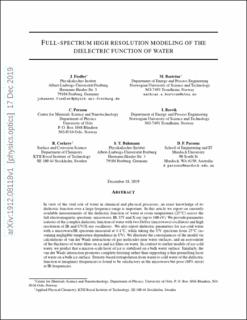| dc.contributor.author | Fiedler, Johannes | |
| dc.contributor.author | Boström, Mathias | |
| dc.contributor.author | Persson, Clas | |
| dc.contributor.author | Brevik, Iver Håkon | |
| dc.contributor.author | Corkery, R. | |
| dc.contributor.author | Buhmann, S. Y. | |
| dc.contributor.author | Parsons, D. F. | |
| dc.date.accessioned | 2022-06-28T11:02:49Z | |
| dc.date.available | 2022-06-28T11:02:49Z | |
| dc.date.created | 2020-04-02T11:39:15Z | |
| dc.date.issued | 2020 | |
| dc.identifier.citation | Journal of Physical Chemistry B. 2020, 124 3103-3113. | en_US |
| dc.identifier.issn | 1520-6106 | |
| dc.identifier.uri | https://hdl.handle.net/11250/3001296 | |
| dc.description.abstract | In view of the vital role of water, exact knowledge of its dielectric function over a large frequency range is important. We report on currently available measurements of the dielectric function of water at room temperature (25 °C) across the full spectrum: microwave, IR, UV, and X-ray (up to 100 eV). We parameterize the complex dielectric function of water with two Debye (microwave) oscillators and high resolution of IR and UV/X-ray oscillators. We also report dielectric parameters for ice-cold water with a microwave/IR spectrum measured at 0.4 °C, while taking the UV spectrum at 25 °C (assuming negligible temperature dependence in UV). We employ van der Waals dispersion interactions to contrast our model of ice-cold water with earlier models. Air bubbles in water and dissolved gas molecules show attraction toward interfaces rather than repulsion. The van der Waals interaction promotes complete freezing rather than supporting a thin layer of water on ice. We infer that premelting is driven by charge and ion adsorption. Density-based extrapolation from warm to cold water of the dielectric function is satisfactory in microwave but poor (40% error) at IR frequencies. | en_US |
| dc.language.iso | eng | en_US |
| dc.publisher | American Chemical Society | en_US |
| dc.title | Full-Spectrum High-Resolution Modeling of the Dielectric Function of Water | en_US |
| dc.type | Journal article | en_US |
| dc.description.version | submittedVersion | en_US |
| dc.rights.holder | This is the manuscript to an article published by ACS | en_US |
| dc.source.pagenumber | 3103-3113 | en_US |
| dc.source.volume | 124 | en_US |
| dc.source.journal | Journal of Physical Chemistry B | en_US |
| dc.identifier.doi | 10.1021/acs.jpcb.0c00410 | |
| dc.identifier.cristin | 1804949 | |
| dc.relation.project | Norges forskningsråd: 250346 | en_US |
| cristin.ispublished | true | |
| cristin.fulltext | preprint | |
| cristin.qualitycode | 2 | |
